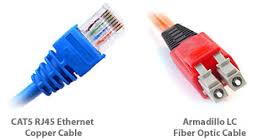Deciding to build your data center architecture using fiber, copper or the selective use of both depend on a variety of criteria including:
- Bandwidth and performance of computing equipment required per data center area

- Immunity to Electromagnetic Interference (EMI) and Radio Frequency Interference (RFI)
- Need for density and space saving connectivity
- Flexibility and speed of reconfiguration
- Device media interface considerations
- Standardization
- Future vision and tolerance for recabling
- Cost of electronics.
Fiber can provide numerous advantages over twisted-pair copper in a data center environment that allow network designers to benefit from new data center architectures. These advantages include:
- Greater bandwidth and error-free transmission over longer distances
- Simpler testing
- Immunity to EMI/RFI.
As space is always a consideration, high-density fiber optic systems may be preferred for maximizing valuable space. Fiber’s small size and weight requires less space in cable trays, raised floors and equipment racks. As a result, smaller optical networking provides better under-floor cooling and gives precious real estate back to the data center.
Supporting Higher Data Rates
Fiber has the ability to support higher data rates, taking advantage of existing applications and emerging high-speed network interfaces and protocols.
Multimode fiber optics support:
10 Mbps/100 Mbps/1 Gbps/10 Gbps/40 Gbps/ 100 Gbps Ethernet
1/2 /4/8/16 Gbps Fibre Channel
Laser optimized 50-micron/ISO OM3 and OM4 fiber is generally recommended by storage area network manufacturers because of its higher bandwidth capabilities
Copper
There are three strong reasons for the broad acceptance and rapid growth of twisted-pair as the cabling media of choice for switch-to-server interconnect:
- Low initial cost
- Ability to deliver higher data rate LAN services
- Flexibility to use one medium for all services.Growth in 10 Gigabit Copper Solutions
Growth in 10 Gigabit Copper Solutions
10 Gigabit Ethernet technology continues to evolve and improve, causing wider adoption. Blade servers, networked enterprise switches, video servers and other applications can benefit now from 10 Gigabit speeds in storage, system backup, teleconferencing and surveillance. Technical advances have enabled the higher density, reduced power and improved cost-effectiveness needed to attract all of the major system developers. For example, the development of 10GBASE-T by the IEEE 802.3an committee is expected to only accelerate this market acceptance as 10 Gigabit Ethernet can be delivered over a twisted-pair cabling using the ubiquitous RJ45 physical interface.